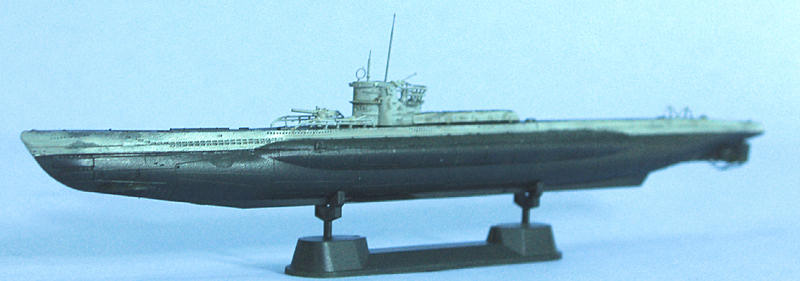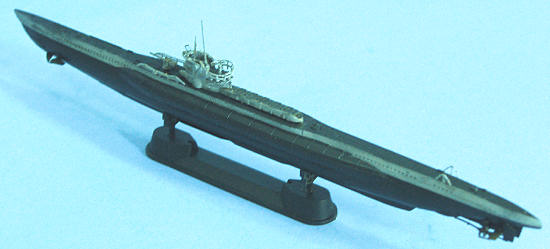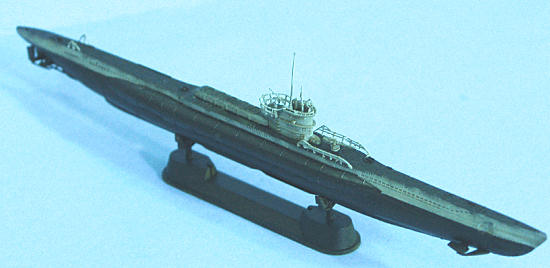AFV Club 1/350 U-boat type VIID

The Type
VII
U‑boat first appeared as the VIIA in 1936. While it was not the best submarine
in any particular aspect, it was the most successful submarine of the Second
World War, forming the backbone of the U‑boat force throughout the war.
The Type
VII
became the main craft of the U‑boat force for two reasons. The first was
technical. The Type
VII
had the range, sea worthiness, armament, and maneuverability to conduct an
anti‑shipping war in the
North Atlantic.
Additionally, the Type
VII
was relatively cheap and could be built quickly using mass‑production
techniques. Secondarily, naval
policy influenced the selection.
Under the 1935 Anglo‑German Naval Agreement,
Germany
was allowed to construct submarines up to 35 percent the tonnage of the Royal
Navy submarine fleet, which was later increased to 100 percent. The Type
VII,
as a medium‑tonnage boat, could be built in greater numbers under these
restrictions.
 709 Type
VII
U‑boats of all variants were built during the war, more than any other submarine
type built by any other nation. The U‑boat appeared in seven main variants:
VIIA, VIIB, VIIC, VIIC/41, VIIC/42, VIID and VIIF.
709 Type
VII
U‑boats of all variants were built during the war, more than any other submarine
type built by any other nation. The U‑boat appeared in seven main variants:
VIIA, VIIB, VIIC, VIIC/41, VIIC/42, VIID and VIIF.
One of the most successful weapons in naval warfare was the mine.
While the smaller U‑boars could deliver mines through their torpedo
tubes, only the XB U‑boats, which were specifically designed as minelayers,
could deliver the SMA cable anchored mines. The XBs were large and unwieldy, and
could only be used as minelayers since their only other armament was two
stern‑mounted torpedo tubes.
Because of this, only eight XBs were built and commissioned.
However, the SMA was the best type of mine, so the Oberkommando der
Kriegsmarine directed that the Type VIIC U‑boat be modified to enable it to
deliver SMA mines while maintaining the full offensive capabilities of the Type
VIIC. The result was the Type VIID, designed to lay SMA type mines in British
coastal waters. Using the basic Type VIIC, a new hull section was inserted aft
of the control room, containing five vertical mine launchers which could each
carry three SMA mines, which increased overall length from 217 to 250 feet. The
saddle tanks were also lengthened, which provided a larger load of diesel fuel,
giving the Type VIID greater range than the Type VIIC.
However, due to its increased size and weight, the Type VIID had
marginally poorer maneuverability, and a slower top speed and diving time. Six
Type VIIDs ‑ U‑213 to U‑218 ‑ were built by the
Germania
Shipyard in
Kiel
and commissioned between August 1941 and January 1942.
Of 31 patrols carried out by Type VIIDs between the Spring of 1942 and
the end of the war, only nine were minelaying missions.
On
October 10, 1945,
the British trawler “Kned” fell victim to a mine laid by U‑218 on
August 18,1944.
The six Type VIIDs sank ten ships for a total 42,622 tons.
 After May 1943, the remaining Type VIIDs were stripped of their 88mm deck
guns and given a second flak platform over the first two mine silos. In 1945,
U‑218 was fitted with a snorkel.
After May 1943, the remaining Type VIIDs were stripped of their 88mm deck
guns and given a second flak platform over the first two mine silos. In 1945,
U‑218 was fitted with a snorkel.
U‑213, which made 5 patrols and sank no ships, was sunk off the Azores on
July 31,1942 by depth charges from HMS Erne, HMS Rochester and HMS Sandwich with
loss of all hands. U‑214 made 11 patrols and sank 3 ships before being sunk on
July26, 1944 in the
English Channel
by HMS Cooke with loss of all hands. U‑215 made one patrol, sinking one ship,
before being sunk with all hands in the
North Atlantic
while on a minelaying operation.
U‑216 also made one patrol and sank one ship before being sunk on
October 20 1942
by a Liberator off the southern coast of
Ireland.
U‑217 made three patrols and sank three ships before being sunk in the
North Atlantic on June 5, 1943, by Avengers from USS Bogue.
U‑218, the most successful of the class, made ten patrols between the
summer of 1942 and the end of the war, sinking three ships.
The U‑boat sailed into
Bergen,
Norway,
to surrender on
May 8, 1945,
and was lost in the
North Sea
while under tow by HMS Southdown during “Operation Deadlight” on
December 4, 1945.
AFV
Club's 1/350 Type VIId follows their earlier Type VIIB and Type VIIC U-boats,
and joins the Revell 1/350 Type VIIC and Hobby Boss 1/350 Type XIB and Type IXC
to bring the grey wolves of the Kriegsmarine to this scale.
The
AFV
Club kit is extremely petite, with fewer than 35 parts, but many of these parts,
like the railings, are so well done in such small detail that they are superior
to the photoetch parts that are provided.
Decals allow the modeler to make any one of the Type VIId U-boats to see
service.
When one builds something that is only about 6 inches long, with lots of
really small detail parts that are ‑ in 1/350 scale ‑ really really small
detail parts, it's a goo d idea to have a nice swing‑arm magnifier lamp
available. I did almost all the
work on this tiny model under the light and with the visual aid of that lamp.
d idea to have a nice swing‑arm magnifier lamp
available. I did almost all the
work on this tiny model under the light and with the visual aid of that lamp.
I have done the
AFV
1/350 Type VIIB, and this differs only in adding the bit of superstructure over
the mine compartment and the fact the hull is a bit longer.
The nice thing is that, as is true with most submarine models, it is easy
to assemble even in this scale, due to the relative paucity of parts compared to
any other ship model. The
instructions are clear and concise.
I first assembled the hull, then attached the diving planes, the screws
and the rudders. This hull is more
fiddly than the Revell kit, but the result has better detail to my mind.
I then assembled the conning tower, with the plastic railing, at glued it
to the hull. I left all the small
deck parts off until after the model was painted.
The hull below the waterline was painted with Tamiya “NATO Black”, with
the upper decks painted the same color and then having the bow and stern painted
with
Dark
Sea
Grey. The hull above the waterline
and the conning tower were painted German Kriegsmarine Grey.
I attached the various parts. I used the plastic railings, which are
among the most delicate plastic moldings I have ever seen, and which look great
on the finished model. When all had set up, I gave the model an overall coat of
Xtracrylix Flat Varnish.
 Wow! U‑boats were really
small! Being able to put this model
near other ships made in the same scale, one is amazed to discover how really
small this most important weapons system of the Second World War ‑ the German
weapon that came closest to winning the war for Hitler ‑ really was.
You don't get this with the larger scales, since there is nothing really
big to compare the model with. I
think I may put some photoetch figures on the conning tower deck, so others who
see this can get an idea of just how small these ships were, and how brave a man
had to be to go to war in them.
Wow! U‑boats were really
small! Being able to put this model
near other ships made in the same scale, one is amazed to discover how really
small this most important weapons system of the Second World War ‑ the German
weapon that came closest to winning the war for Hitler ‑ really was.
You don't get this with the larger scales, since there is nothing really
big to compare the model with. I
think I may put some photoetch figures on the conning tower deck, so others who
see this can get an idea of just how small these ships were, and how brave a man
had to be to go to war in them.
Tom
Cleaver
November 2010
Review kit courtesy of
HobbyLink
Japan.
If you would like your product reviewed fairly and quickly, please
contact
me or see other details in the Note to
Contributors.Back to the Main Page
Back to the Review
Index Page


 709 Type
709 Type

 d idea to have a nice swing‑arm magnifier lamp
available. I did almost all the
work on this tiny model under the light and with the visual aid of that lamp.
d idea to have a nice swing‑arm magnifier lamp
available. I did almost all the
work on this tiny model under the light and with the visual aid of that lamp. Wow! U‑boats were really
small! Being able to put this model
near other ships made in the same scale, one is amazed to discover how really
small this most important weapons system of the Second World War ‑ the German
weapon that came closest to winning the war for Hitler ‑ really was.
You don't get this with the larger scales, since there is nothing really
big to compare the model with. I
think I may put some photoetch figures on the conning tower deck, so others who
see this can get an idea of just how small these ships were, and how brave a man
had to be to go to war in them.
Wow! U‑boats were really
small! Being able to put this model
near other ships made in the same scale, one is amazed to discover how really
small this most important weapons system of the Second World War ‑ the German
weapon that came closest to winning the war for Hitler ‑ really was.
You don't get this with the larger scales, since there is nothing really
big to compare the model with. I
think I may put some photoetch figures on the conning tower deck, so others who
see this can get an idea of just how small these ships were, and how brave a man
had to be to go to war in them.